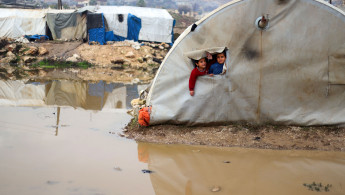Panic in northern Syria as leishmaniasis, TB and measles return
Diseases such as leishmaniasis, tuberculosis, and measles have returned to northern Syria, The New Arab’s Arabic language sister site Al-Araby Al-Jadeed has reported, causing panic in camps.
A high population density in opposition areas of Idlib and Aleppo has led to a decline in sanitary conditions, as Syrians living in overpopulated camps struggle to access clean water, soap, and health services.
"After the outbreak of the Syrian revolution, the waves of displacement and the lack of attention to the environment and health awareness led insects [and disease] to spread," Reham Weiss, the health awareness officer at the Syrian American Medical Society (SAMS), told Al-Araby Al-Jadeed.
Sandflies, which populate polluted and swamp-like areas, are now abundant in northwest Syria. As a result, leishmaniasis - a parasitic disease - has emerged.
Among those stung by the fly was seven-year-old Manal Al-Sheez.
"It disfigured her face and affected her psyche, she has not recovered yet despite becoming ill about two years ago," her mother told Al-Araby Al-Jadeed.
Teacher Fatima Al-Saadi (a psuedonym) has stopped working in camps in the town of Tal Al-Karama and started home-schooling her daughter due to an outbreak of head lice among students.
"The mixing of children makes it more difficult to curb the spread of illnesses," Al-Saadi said.
Northern Syria has seen a growing number of measles cases, concentrated in the Azaz area where 15 cases were detected in the last week of April alone.
There are also fears that tuberculosis (TB) is spreading in the region with the average number of monthly cases at treatment centres reaching 35, Al-Araby Al-Jadeed reported.
Weiss urged that preventive measures be implemented in camps this summer to prevent the situation from getting worse, saying that insecticides should be used.
A lack of a clear mechanism for examining and diagnosing cases is an issue in the region, Weiss said.
High levels of displacement have made it difficult to provide the necessary treatment to patients and follow up on active cases.
There are around 1,489 camps in northern Syria inhabited by roughly 1.5 million IDPs who left their homes over the course of the decade-long Syrian civil war, which has killed over 500,000 people.
The conflict has brought health services across the country to the point of collapse, with hospitals barely functioning and many qualified doctors and nurses fleeing abroad.
Hospitals, clinics, and health workers have all been targeted by Russia and the Syrian regime throughout the war, compounding the crisis in the health sector.





 Follow the Middle East's top stories in English at The New Arab on Google News
Follow the Middle East's top stories in English at The New Arab on Google News


